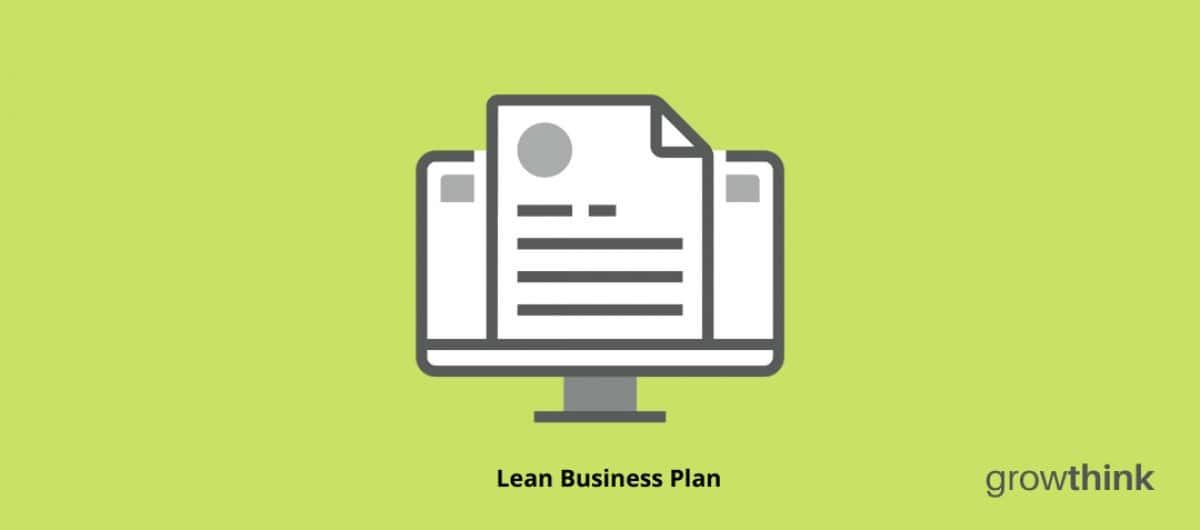Historically, business owners have devoted months to constructing a detailed plan to establish strategy, executive, and financial numbers for their business. Although a strategic plan is often created, these entrepreneurs often miss a big piece: gathering feedback from potential customers.
Without collecting data and insight from target customers, the detailed business plan becomes a document of assumptions and guesses rather than a proven success blueprint.
Lean business planning allows you to more quickly and accurately develop your business plan based on actual customer feedback and interactions.
On this page:
Key Benefits of Lean Startup Business Planning

The lean startup business model is supported by a one-page business plan that does not require extensive financial forecasting or long-term market research and development plans. While the traditional business plan details every aspect of your company’s operations, the lean business plan focuses on key factors that present immediate opportunities for new companies to gain a competitive advantage over their competitors. This approach allows you to maintain company focus on your core mission and avoid adding unnecessary information that can weigh down your final document.
The lean startup movement has encouraged entrepreneurs to shorten their plans down from hundreds of pages to a one-page business plan or less – essentially eliminating the need for small businesses to create traditional plans at all. Rather than spending time creating lengthy reports, owners can simply list their core values, mission statement, market analysis, marketing strategies, and projected financial statements – all on one page.
Some companies even document their entire value proposition on a single sheet of paper which serves as both the foundation for further market research and development to improve its product or service offering. By having this type of information readily available to share with investors or clients, your company will appear more professional and prepared without taking up too much time creating unnecessary documentation.
Can You Use a Lean Plan to Raise Funding?
Developing a lean business plan is a critical step in launching or growing your business. However, it’s important to note that if you’re seeking VC funding, bank funding, or angel investors, a traditional business plan is required. Such a plan includes additional research, strategy, and financial forecasts to give investors and lenders the information they need to determine whether they will receive an adequate ROI (return on investment) if they provide funding to you.
Key Elements of a Lean Business Plan
Below are nine key elements of a lean business plan example:
- Business overview
- Value propositions
- Key partnerships
- Key activities
- Key resources
- Customer relationships
- Customer segments and channels
- Cost structure
- Revenue streams
Describe what the business does.
Detail the value your business brings to the market and the industry.
List the key partners, including suppliers, manufacturers, distributors, vendors, or software firms, with whom your business will work.
List the key activities your business will perform to gain a competitive advantage, grow market share, and fuel profits.
List the resources that your business has at its disposal to create maximum value. This could include human capital (your own experience or that of your core team), intellectual property, patents, funding, etc.
Describe how your customers will interact with your business. Will you have personal or automated channels of communication available? Chart out the end-to-end customer experience journey and how you intend on building customer relationships.
Specify your target audience, what requirements of theirs you cater to, how you reach out to them, and, most importantly, the steps you are taking to generate a customer experience that will result in long-term loyalty.
Define your key costs and variable costs, and how they represent a competitive advantage if applicable. A lean startup business plan (versus a lean business plan for an existing company), needs to also include key startup costs you anticipate in launching your company.
Describe how your business generates money. What are your revenue streams or sources, for example, selling advertising space on your app or publication, membership fees, direct sales, etc? List all your revenue sources in this section, starting with the source that delivers the largest revenue.
Lean Business Planning Process

To create your lean business plan, follow these 4 steps:
- Create the Plan
- Course of Action
- Target market
- Pricing
- Online presence
- Advertising
- Public relations
- Special promotions
- Schedule
- Forecast and Budget
Your lean business plan will start with you, your business idea, and one sheet of paper. Yes, one sheet is all you will need.
Business Strategy
You will first begin by explaining your business strategy. This is simply a summary of what you are planning to do, who your customers are, and who your competitors are.
Identify the problem you are trying to solve along with your solution and potential alternative solutions. Then, describe your target customers. Focus on defining and describing the audience you expect to serve, who they are, where they live, etc. Lastly, explain who your competitors are. Describe what they’re doing and how they’re doing it.
Easy enough, that is all you need for your plan. With lean business planning, you simply create a business strategy that focuses on the essence and function of your business: what you’re doing and who it’s for.
The next piece of your lean business plan is laying out an outline of your course of action. This section will illustrate how you’re going to make your strategy happen. Here, you will focus on sales, marketing, your team members, and any potential key partners or future relationships in the business world.
Sales Strategy
It is important to first begin creating your course of action by establishing just what your sales strategy is. Will you be selling in a physical store or online? Or both? Consider whether or not your product will be sold in stores owned by other companies, and who these companies would be.
Marketing Strategy
Next up is creating your marketing strategy. Think about how you will effectively and attractively reach your potential customers. Here, consider the following:
Team Members
The success of your course of action will be dependent on the team members who execute it. If you need to build a team, think about who the key people are that you will need to hire. What are their qualifications and characteristics? If you already have an existing business, highlight the key members that help run your company and accomplish strategy and success.
Partners and Business Resources
Begin to think of the other businesses that you might want to work with. Most likely there are other companies that you will have to work with to make your strategy work. Brainstorm all key resources, business partners, distributors, and key suppliers that you will need to have relationships with.
After constructing your Course of Action, it’s time to create your schedule. Since lean business planning is centered around efficiency, designing an organized schedule is key.
For startups:
If you’re starting a new business, you should begin with getting to know your customers. For you to grow a viable business, you must understand your customers’ views, wants, and needs. Your goal here will be to ensure that you’ve developed a strategic, organized strategy. A startup’s schedule will often include sending out surveys, interviewing customers, and researching locations.
For established businesses:
For most businesses that have been around, your schedule should be focused on achieving the business goals you have identified. Your schedule should have specific actions with names, dates, and even times. The schedule you create should hold your business and its employees accountable for their work and progress.
The final part of scheduling is to make time to regularly review your Lean Business Plan. As your business progresses, so will your Lean Business Plan. Setting a regular review time is critical to get your business moving in the right direction and your team members on board.
Even if you have the best business idea in the world, if the numbers aren’t there, it won’t work out. The final section of your Lean Business Plan should depict a business model that forecasts and budgets for the future.
Here, all you have to do is create basic bottom-up sales forecasts and a basic budget for expenses. Do not try to sugarcoat here, these numbers should be as practical as possible. With this, you will be able to identify just what will and won’t work for your business.
By taking on this pragmatic sense, you may begin to feel like your business will not be able to succeed unless you are flooding with customers or getting daily news coverage. You may need to alter your business model here and adjust your pricing and expenses to ensure that you can turn a profit. Also, keep in mind any funding options for large-scale marketing and PR campaigns. Keep a realistic view, but also be sure to acknowledge offers that may be available to help you out.
Putting The Lean Business Plan Into Action
After you have completed your lean business plan, it’s time to put it into action. Your main goal here should be to get a deeper understanding of your customers. Is your product solving their problem? Are they willing to pay for it? Do they want something else?
Reaching out to your customers early on will help you get a grasp on their wants and needs to make the necessary alterations to your Lean Business Plan for ultimate success. It will also provide you with some insight as to what products you may want to produce in the future.
Review Your Results & Revise Your Plan

As earlier mentioned, your lean plan should be reviewed regularly to discern just what is working and what isn’t. Compare your results with your lean plan. Are sales growing according to plan? Does the plan need to be changed?
For startups who have little to no metrics to track, review your customer interviews, surveys, or any other information that you have gathered about the industry. Here, you can begin to continually refine your plan and strategy if necessary.
If you are an established business, review your recent results with those from the past. Take note of your key metrics as well as foot traffic in stores, website visits, and any other critical units of measure for your business success.
After analyzing your results, it’s time to revise your plan. Remember that your Lean Business Plan is a process rather than a finalized document, and it is made for continuous improvements. Don’t be afraid to make any necessary changes to aid in your business’s success.
Conclusion
Lean business planning might just be the key to your company’s ultimate success. This simple method of business planning has helped many startups and existing businesses advance and flourish such as Google, Facebook, YouTube, and Amazon. By focusing on reviewing, revising, and business management, lean planning allows you to test out different strategies to find the best one to create a successful business.
How to Finish Your Business Plan in 1 Day!
Don’t you wish there was a faster, easier way to finish your business plan?
With Growthink’s Ultimate Business Plan Template you can finish your plan in just 8 hours or less!
Lean Business Plan FAQs
What is a lean business plan?
A lean business plan is a compact, single-page document typically for internal use. Lean planning is a short-term business plan strategy for making small changes and measuring the results to improve the efficiency of the business. This compares to the formal business plan which is typically very detailed, includes 10 key components, and can be up to 15-25 pages in length.
What is the purpose of a lean business plan?
The lean business plan is primarily for internal use, so it doesn’t have to be a fancy document. The purpose of this plan is for you to document the changes you’ve made to your business so that you can analyze their effectiveness in improving business operations, marketing, and/or sales over a short period.
How long is a lean business plan?
The lean business plan is typically a one-page document to describe your business strategy including your goals, targeted audience, your business model, and how your sales and marketing strategies work to support your business goals.
How do you create a lean business plan?
Refer to our article on ‘Lean Business Plan: How-To Guide & Template’ for the 4 steps in creating a lean business plan or a lean startup business plan template. You can also download our free lean plan template to help you get started.


 Customizable Business Plan Template
Customizable Business Plan Template How to Write a Business Plan
How to Write a Business Plan The Perfect Business Plan Outline for a Great Plan
The Perfect Business Plan Outline for a Great Plan Use This Business Plan Format to Expertly Write Your Plan
Use This Business Plan Format to Expertly Write Your Plan 150 Sample Business Plans
150 Sample Business Plans Finding a Business Plan Consultant
Finding a Business Plan Consultant How to Write a Business Plan Executive Summary
How to Write a Business Plan Executive Summary 10 Key Components of a Business Plan
10 Key Components of a Business Plan What is a Business Plan?
What is a Business Plan? Benefits of Hiring a Business Plan Writer
Benefits of Hiring a Business Plan Writer How to Create a One Page Business Plan with Template
How to Create a One Page Business Plan with Template Business Plan Software Options
Business Plan Software Options How to Write the Business Plan Management Team Section
How to Write the Business Plan Management Team Section How Long Should a Business Plan Be?
How Long Should a Business Plan Be? Growthink Reviews
Growthink Reviews